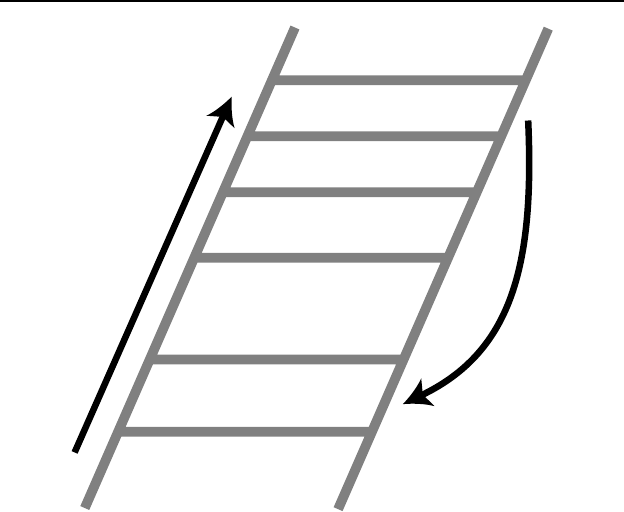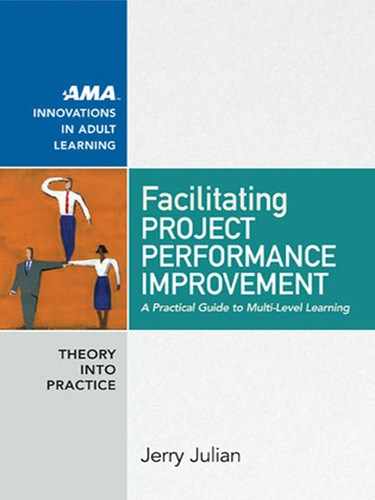
The Multi-Level Learning Coach 59
American Management Association
www.amanet.org
trying to avoid embarrassment or threat by placing demands on the other.
As touched upon in Chapter 1, Argyris (1995) describes organizational de-
fensive routines as “any action, policy, or practice that prevents organiza-
tional participants from experiencing embarrassment or threat and, at the
same time, prevents them from discovering the causes of the embarrass-
ment or threat” (pp. 20–22). Perhaps both managers thought that they did
not have the skills required to enable the project to succeed, and because
of their escalating con ict, they may have become even more invested in
“winning” by placing responsibility on the other party in order to avoid
personal failure.
Because climbing the Ladder of Inference occurs in the minds of other
people, it’s impossible to know what Bernard and Tracy were thinking at
the time. However, what is known is that the project was delayed for weeks
because of this stalemate, and that this ultimately led to the project’s being
Select Data from
What’s Observed
Ascribe Meanings
to the Data Selected
(based on cultural and
personal experiences)
Make Assumptions Based on
the Meanings Added
Draw Conclusions
Adopt Beliefs About the World
Take Action
Observable
Data
Beliefs
filter
the data
selected
FIGURE 3.3
The Ladder of Inference [Adapted from Argyris (1990)]
60 Roles
American Management Association
www.amanet.org
cancelled by the CIO. Both managers were reassigned to roles with sig-
ni cantly less responsibility, which leads us to believe that their defensive
routines and poor communication led to less than optimal results both for
them and for their organization.
O’Neil and Marsick (2007) o er the TALK model, a straightforward
tool that multi- level learning coaches can use to help both themselves and
their clients communicate in ways that, rather than triggering defensive
routines, lead to interactions that are more consistent with the three core
values of facilitation. The model is a sequential approach to communicat-
ing, and it is an acronym for the four steps involved: Tell the person what
you are thinking from the start, ask whether he has the same interpreta-
tion of the situation, listen to his response, and keep open to others’ views.
Shared meaning, they say, can come only from accepting and bringing to
the surface our multiple understandings, those that represent the various
rungs on the Ladder of Inference.
Productive communication, as mentioned previously, underpins all the
elements of an e ective group process. An e ective approach to manag-
ing con ict, along with e ective communication, for example, might also
have helped Bernard and Tracy resolve their di erences. We will discuss
con ict management later in this chapter. We now turn to another impor-
tant component of group process, a model for group problem solving.
Problem Solving
Much of a team’s work is focused on problems. Problems in this context
are simply a gap between what is desired and what currently exists. The
central elements of problem solving are the following steps, which can be
seen both on a macro level (in project plans, for example) or on a micro
level (in meeting agendas focused on more speci c issues): Identify the
problem, collect data about the problem, analyze the data to determine
the root causes, develop possible solutions, select the most appropriate
solution, implement the solution, and evaluate and monitor the situation
after implementation. Project methodologies such as Six Sigma, TQM,
and other quality improvement approaches build these steps directly into
project plans in order to generate sustainable improvements that focus
not just on symptoms, but on solving the root causes of problems so that
they don’t recur.
The Multi-Level Learning Coach 61
American Management Association
www.amanet.org
Most readers will nd nothing conceptually di cult about this model
and may even be wondering why such a basic topic is being addressed
here. The hard part about working with groups is not helping them
understand the model, it’s helping individuals clarify what stage of the
problem- solving process they are in so that they can collaborate e ectively
at each stage. This becomes the basis for the multi- level learning coach to
intervene to help people focus on the right place at the right time. This is
consistent with the value described earlier of helping teams acquire valid
information that enables individuals to make free and informed choices.
Decision Making
Groups use a variety of ways to make decisions, some more formal than
others, and some more important than others in their scope and mag-
nitude. Yet e ective decision making is essential if people are to work
together productively in a team format. Decision making includes who
should be involved, when, in what decisions, and how the choice will be
made (Schwarz, 1994). An e ective decision has the following character-
istics: It takes all relevant data into account, team members accept it and
will work to implement it, and the decision is made in an appropriate
amount of time. Again, these characteristics are consistent with the ideals
of valid information, free and informed choice, and internal commitment.
While not all decisions need to be made by consensus, these three ideals
point to the superiority of consensus for helping people make free and
informed choices to which they are internally committed. However, time
and resource limitations don’t always enable full consensus to be achieved,
and not all decisions require such investment. The coach, team leader, and
group members should decide in advance the who, when, what, and how
of decision making before signi cant choices that a ect group members
and stakeholders in the organization have to be made.
A useful model for clarifying decision processes entails identifying who
should recommend the appropriate course of action, who should approve
the decision, who should be consulted prior to the decision’s being made,
and who should be informed after the fact. This model, called the RACI
model, helps clarify the roles of individuals inside and outside the team in
the decision- making process. In situations in which consensus is desirable
and the time can be dedicated to achieving it, all group members would
62 Roles
American Management Association
www.amanet.org
be assigned A, for approve. Often, however, a subgroup or an individual
with expertise in a speci c area may recommend a course of action to the
entire group. In such cases, this person or subgroup would be labeled R. In
still other cases, people may not want to either recommend or approve a
decision, but instead should be consulted beforehand so their opinion can
be considered. Finally, those assigned an I would not have in uence over
the decision but would be noti ed of the result in an appropriate amount
of time.
The coach can help teams establish e ective decision making not only
in team meetings, but for the project organization overall. For example,
many project groups have established “gates” through which projects
must pass, such as before systems “go live” or prior to the implementation
of recommendations on a process improvement project. Often, these deci-
sion points are critical not only for project teams, but for stakeholders in
many parts of the organization. Clari cation on who should be involved,
when, and how can help project organizations improve the way they man-
age these important milestones.
Con ict Resolution
The Chinese kanji characters for “con ict” represent both “danger” and
“opportunity.” While con ict can some times be threatening, it also opens
up avenues for collaboration that would not otherwise be possible. Con-
ict is a natural aspect of group activity that, when handled e ectively, can
promote creative solutions by combining the interests, skills, and capabili-
ties of diverse people and perspectives. From this point of view, con ict at
some level may even be necessary if organizations are to surmount sub-
stantive obstacles and deal with their most important challenges. Con ict
is de ned here simply as a situation in which two or more parties have
interests or needs that di er in some way and that need to be resolved in
order for a group to move forward. Interests and needs can be either tangi-
ble or psychological. And they must be satis ed in some way (or changed)
for the individuals involved to reach a sustainable outcome. Examples of
tangible needs include equipment, tools, and resources to perform a task.
Psychological needs include things like respect, autonomy, recognition,
belonging, and safety.
The Multi-Level Learning Coach 63
American Management Association
www.amanet.org
A useful framework for understanding the di erences in how people
relate to con ict—and a path forward for helping teams become more ef-
fective at handling it—is re ected in the dual concerns model depicted in
Figure 3.4, a version of which is incorporated into the Thomas- Kilmann
con ict mode instrument (Kilmann & Thomas, 1977). The horizontal axis
represents the degree to which an individual or group is attempting to
satisfy others’ concerns. The vertical axis represents the degree to which
someone is attempting to satisfy her own concerns. The result leads to ve
di erent styles that people bring to con ict situations: competing, avoid-
ing, accommodating, compromising, and collaborating. The approach
that is most suitable for a given situation depends on the degree to which
an ongoing relationship needs to be maintained and the importance of the
outcome to participants. For example, if an individual inadvertently says
something that is irritating or o ensive to another, it may be worth avoid-
ing, given the low degree of severity and impact. However, in situations
where two or more individuals are responsible for making choices that af-
fect others in a signi cant way, such as in the case of important project de-
cisions, strategy formulation, or process designs, a collaborative approach
to negotiating a successful outcome is preferable, as it enables multiple
perspectives to be combined. No party to the decision “caves in,” tries to
“win” at the expense of others, avoids the decision, or compromises his
views to accommodate others. Rather, each fully represents her point of
view, advocating it with an appropriate level of assertiveness and with an
appropriate degree of cooperation that seeks to inquire and understand
the underlying basis for others’ points of view.
In their book Getting to Yes, Roger Fisher and William Ury (1991) out-
line a number of steps that participants can take to resolve con icts in a
collaborative way, reaching outcomes that satisfy all parties’ needs in a
win- win fashion. They help us to realize that bargaining over positions can
often lead to ine ective solutions, with results that are potentially damag-
ing to the people involved. Positions can be viewed as opening demands,
and may come in the form of something like, “We don’t have additional
resources to put into this e ort.” They can come in the form of posturing
or blaming as a way of protecting one’s own interests, as when someone
says, “You’ve consumed enough time from our department on this project
already.”
..................Content has been hidden....................
You can't read the all page of ebook, please click here login for view all page.
